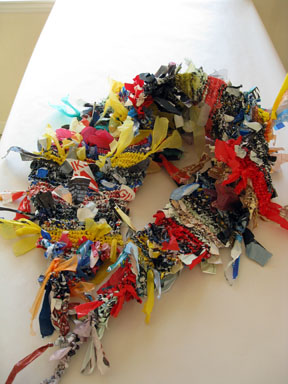Culled from the "recycle" bins in front of grocery stores, brightly colored plastic bags (I am fond of those with lots of advertising pictures and text) were cut into strips to make the "yarn" then knitted to make these wraps. Recycling has its place - however, it's not the solution to the plastic bag problem. Recycling rates for plastic bags are extremely low. Only 3% of plastic bags end up getting recycled. Furthermore many bags collected for recycling never get recycled. A growing trend is to ship them to countries like India and China which are rapidly becoming the dumping grounds for the Western world's glut of recyclables. Rather than being recycled they are cheaply incinerated under more lax environmental laws.
Although I am keen on knitting these wraps, revisioning the plastic into a "fashion statement" I would much rather that folks refuse plastic bags in the first place. Then I can get back to knitting with something stickier like scotch tape.
Like Diamonds...Plastic is Forever at the Bolinas Museum, 2014
Advert
Length 75"
Boa, Boa
Length 170"
Cordon Bleu
Length 60"
In June 2010 Surface Design.org hosted Reinvention, a conference at SFSU, where I wore this BOA wrap and presented my work.https://www.surfacedesign.org/reflecting-on-reinvention/

BOA
• a long thin fluffy scarf of feathers or fur or, in this case, over one hundred plastic bags
• any of several chiefly tropical constrictors with vestigial hind limbs
definition from wordnetweb.princeton.edu/
My compelling feelings for plastic bags are evident in this fifteen foot BOA knitted from single use shopping bags and San Francisco Chronicle newspaper delivery bags.
By giving aesthetic form to what is considered to be garbage, I serve as both cleaner and curator. While the content of my work has a message about the spoiling of the natural world by the human/industrial world, my intention is to transform the perils of pollution into something beautiful and celebratory.
I hope by putting a little fun and fashion into the conservation conversation, that the value of detritus will increase. Soon everyone will be out picking up plastic trash or will be eager to “mine” the North Pacific Gyre for plastic treasures. Then, we get some great things to wear and to look at, plus we get a clean and healthy planet.
Judith Selby Lang
2010





